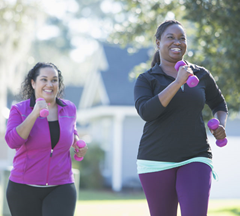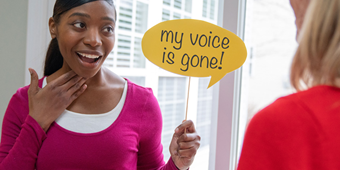Do You Have Osteoporosis, the Silent Disease?

Find Your Perfect Match
Answer a few questions and we'll provide you with a list of primary care providers that best fit your needs.
We’ve all seen it, in popular culture and in real life: the “little old lady,” a frail, elderly woman with a hunched back, walking with a cane. It’s a classic stereotype, but for far too many women, this really is what osteoporosis can look like if not prevented or detected early.
Although osteoporosis can strike anyone, of either sex, at any age, it is most common among older women. According to the Centers for Disease Control, 10 percent of women in their 60s, 27 percent of women in their 70s, and 35 percent of women who are 80 and older have the disorder.
What Is Osteoporosis?
Osteoporosis literally means “porous bone.” It’s a disorder that leads to thin and weakened bones, making them more prone to fractures. Because there are usually no symptoms until a bone is broken, it is often called a “silent” disease.
How Does Osteoporosis Occur?
Our bones may seem as impermeable as a rock, but they are actually living tissue. Your body is constantly breaking down old bone tissue and replacing it with new tissue. Under a microscope, this healthy bone tissue looks like a honeycomb.
Around the age of 30, the production of new bone tissue begins to slow. Gradually, your body will break down more bone tissue than it replaces. As a result, the holes in the “honeycomb” get bigger. This weakens bones, making them easier to break.
If your bone density is low, but not low enough to be diagnosed as osteoporosis, you have osteopenia. Your doctor will work with you to slow down the progression of the disorder before it develops into full-fledged osteoporosis, through diet, exercise, and other means.
Why Is Osteoporosis Harmful?
Bone fractures can result in painful, debilitating, and expensive medical problems. Fractures from osteoporosis are most likely to occur in the hip, spine, or wrist, but other bones can break too. The bones soften, as well. Ultimately, this can lead to:
- Chronic pain
- Reduced height and a stooped or hunched posture, especially when osteoporosis affects vertebrae (the bones in the spine)
- Limited mobility, which can lead to feelings of isolation or depression
- The need for long-term nursing home care
Additionally, 20 percent of seniors with broken hips die within one year, either from complications related to the broken bone itself or the surgery to repair it.
As the U.S. population ages, the number of people experiencing fractures due to osteoporosis will continue to rise. According to the National Osteoporosis Foundation, osteoporosis is responsible for two million broken bones and $19 billion in related costs every year. By 2025, experts predict that will increase to approximately three million fractures and $25.3 billion in costs annually.
Dr. Jennifer Jerele explains how low bone density or osteoporosis puts women at higher risk of having a fragility bone fracture.
Click play to watch the video or read video transcript.
What’s My Risk?
These factors put you at risk for osteoporosis:
- Gender. Women are at higher risk than men.
- Aging. The older you are, the greater your risk.
- Menopause. Menopause brings about changes in hormones, such as a reduction in estrogen. Estrogen helps protect bones in younger women.
- Your body frame. Women who are thin and small-boned (generally under 127 pounds) are at higher risk.
- Ethnicity. Caucasian and Asian women are at higher risk, mainly due to differences in bone density. However, African-American and Hispanic women are still at risk, just less so.
- Certain medical disorders. Rheumatoid arthritis, type 1 diabetes, premature menopause and anorexia nervosa are among several disorders that can affect the health of your bones.
- Medications. Some commonly used medicines can cause loss of bone mass. These include:
- Glucocorticoids. A type of medicine used to control diseases like arthritis, asthma and lupus
- Some anti-seizure drugs
- Gonadotropin-releasing hormones. Used to treat endometriosis
- Antacids containing aluminum. Aluminum blocks calcium absorption.
- Some cancer treatments
- Too much replacement thyroid hormone for an underactive thyroid
- Family history. If you have a family member who has (or had) osteoporosis, your risk of having it goes up.
- Previous fracture. People who have had a fracture after the age of 50 are at high risk of having another.
Although osteoporosis can strike anyone, of either sex, at any age, it is most common among older women.
How Do I Reduce My Risk?

- Diet and nutrition. Most women need to boost their calcium and vitamin D intake. Bones contain a lot of calcium, and getting too little over your lifetime can weaken those bones. We also don’t seem to get enough vitamin D, whether from our diet, supplements or sunlight. Vitamin D helps the body absorb calcium, so fortifying yourself with just one or the other is not enough. You need both.
To stay healthy, bones also need adequate levels of protein, vitamin K, vitamin C, magnesium and zinc.
Follow these tips to improve your nutrition for stronger bones. Learn more about strengthening your bones with dietary supplements.
- Physical activity: Physical activity strengthens your bones as well as the muscles supporting them. It also improves your balance, which helps prevent falls. Experts recommend weight-bearing activities, like walking, dancing, running and climbing stairs. Here are more ideas on physical activities that are appropriate for women at various ages.
- Stop smoking: Cigarette smoke harms your bones and lowers the amount of estrogen in your body.
- Limit caffeine: People who drink a lot of caffeine lose more bone tissue than those who don’t.
- Limit alcohol intake: Alcohol makes it difficult for your body to absorb calcium. Also, if you’re tipsy (or worse) you’re more likely to fall. Experts recommend no more than one drink a day for women.
What Are My Next Steps?
Osteoporosis is a serious disorder, but it can be prevented or its progression delayed, and it can be treated. If you have one or more of the risk factors listed above, talk to your doctor. She may recommend a bone mass density test, and discuss measures to prevent and bone loss.
Dr. Jennifer Jerele talks about scheduling a DEXA scan, which measures bone mass density, to determine if you may have osteopenia or osteoporosis.
Click play to watch the video or read video transcript.
Find Your Perfect Match
Answer a few questions and we'll provide you with a list of primary care providers that best fit your needs.
Sources: Jennifer Jerele, MD, Premier Orthopedics; National Osteoporosis Foundation; Centers for Disease Control; NIH (National Institutes of Health) Senior Health; Womenshealth.gov







